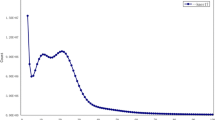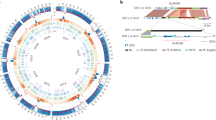Abstract
Carotenoid pigments are important components of the human diet and carrots are the main dietary sources of the vitamin A precursors α- and β-carotene. Carotenoids play essential biological roles in plants and the genes coding for the carotenoid pathway enzymes are evolutionarily conserved, but little information exists about these genes for carrot. In this study, we utilized published carrot sequences as well as heterologous PCR approaches with primers derived from sequence information of other plant species to isolate 24 putative genes coding for carotenoid biosynthesis enzymes in carrot. Twenty-two of these genes were placed on the carrot genetic linkage map developed from a cross between orange-rooted and white-rooted carrot. The carotenoid genes were distributed in eight of the nine linkage groups in the carrot genome recommending their use for merging maps. Two genes co-localized with a genomic region spanning one of the most significant quantitative trait loci (QTL) for carotenoid accumulation. Carotenoid biosynthesis cDNAs linked to root color mutations and to QTL for carotenoid accumulation may suggest a functional role for them as candidate genes. RACE PCR and reverse transcriptase PCR were used to amplify the full-length transcript for twenty expressed carotenoid biosynthesis genes and sequences were submitted to GenBank. The cloning and sequence information of these genes is useful for PCR-based expression studies and may point toward transgenic approaches to manipulate carotenoid content in carrot.



Similar content being viewed by others
References
Bartley GE, Scolnik PA (1995) Plant carotenoids: pigments for photoprotection, attraction, and human health. Plant Cell 7:1027–1038
Boiteux LS, Belter JG, Roberts PA, Simon PW (2000) RAPD linkage map of the genomic region encompassing the root-knot nematode (Meloidogyne javanica) resistance locus in carrot. Theor Appl Genet 100:439–446
Boiteux LS, Fonseca MEN, Simon PW (1999) Effects of plant tissue and DNA purification methods on randomly amplified polymorphic DNA-based genetic fingerprinting analysis in carrot. J Am Soc Hortic Sci 124:32–38
Boiteux LS, Hyman JR, Bach IC, Fonseca MEN, Matthews WC, Roberts PA, Simon PW (2004) Employment of flanking codominant STS markers to estimate allelic substitution effects of a nematode resistance locus in carrot. Euphytica 136:37–44
Bouvier F, Suire C, Mutterer J, Camara B (2003) Oxidative remodeling of chromoplast carotenoids: identification of the carotenoid dioxygenase CsCCD and CsZCD genes involved in crocus secondary metabolite biogenesis. Plant Cell 15:47–62
Bradeen JM, Simon PW (1998) Conversion of an AFLP fragment linked to the carrot Y 2 locus to a simple, codominant, PCR-based marker form. Theor Appl Genet 97:960–967
Bradeen JM, Simon PW (2006) Mapping, markers, and molecular breeding in carrots. In: Cole CR (ed) Genome mapping and molecular breeding, vol 5. Vegetable crops. Science Publishers Inc./IBH Publishing Co. Pvt. Ltd., New Hampshire Oxford/New Delhi
Brauner S, Murphy RL, Walling JG, Przyborowski J, Weeden NF (2002) STS markers for comparative mapping in legumes. J Am Soc Hortic Sci 127:616–622
Buishand JG, Gabelman WH (1979) Investigations on the inheritance of color and carotenoid content in phloem and xylem of carrot roots (Daucus carota L.). Euphytica 28:611–632
Chen X, Salamini F, Gebhardt C (2001) A potato molecular function map for carbohydrate metabolism and transport. Theor Appl Genet 102:284–295
Cunningham FX, Gantt E (1998) Genes and enzymes of carotenoid biosynthesis in plants. Annu Rev Plant Physiol Plant Mol Biol 49:557–583
Demmig-Adams B, Adams WW III (2002) Antioxidants in photosynthesis and human nutrition. Science 298:2149–2153
Doyle JJ, Doyle JL (1990) Isolation of plant DNA from fresh tissue. Focus 12:13–15
Fester T, Hause B, Schmidt D, Halfmann K, Schmidt J, Wray V, Hause G, Strack D (2002) Occurrence and localization of apocarotenoids in arbuscular mycorrhizal plant roots. Plant Cell Physiol 43:256–265
Fonseca MEN (2000) Cloning and expression of carrot (Daucus carota L.) cDNAs coding for enzymes of the carotenoid biosynthetic pathway in roots accumulating different types and amounts of carotenoids. PhD Thesis. University of Wisconsin, Madison, WI
Fraser PD, Kiano JW, Truesdale MR, Schuch, Bramley PM (1999) Phytoene synthase-2 enzyme activity in tomato does not contribute to carotenoid synthesis in ripening fruit. Plant Mol Biol 40:687–698
Fulton TM, Van der Hoeven R, Eannetta NT, Tanksley SD (2002) Identification, analysis, and utilization of conserved ortholog set markers for comparative genomics in higher plants. Plant Cell 14:1457–1467
Gabelman WH, Peters S (1979) Genetical and plant breeding possibilities for improving the quality of vegetables. Acta Hortic 93:243–259
Gallagher CE, Cervantes-Cervantes M, Wurtzel ET (2003) Surrogate biochemistry: use of Escherichia coli to identify plant cDNAs that impact metabolic engineering of carotenoid accumulation. Appl Microbiol Biotechnol 60:713–719
Giuliano G, Al-Babili S, von Lintig J (2003) Carotenoid oxygenases: cleave it or leave it. Trends Plant Sci 8:145–149
Hirschberg J (2001) Carotenoid biosynthesis in flowering plants. Curr Opin Plant Biol 4:210–218
Isaacson T, Ronen G, Zamir D, Hirschberg J (2002). Cloning of tangerine from tomato reveals a carotenoid isomerase essential for the production of β-carotene and xanthophylls in plants. Plant Cell 14:333–342
Knapp SJ, Holloway JL, Bridges WC, Liu BH (1995) Mapping dominant markers using F2 matings. Theor Appl Genet 91:74–81
Lander ES, Green P, Abrahamson J, Barlow A, Daly MJ, Lincoln SE, Newburg L (1987) MAPMAKER: an interactive computer package for constructing primary genetic linkage maps of experimental and natural populations. Genomics 1:174–181
Liu Y-S, Gur A, Ronen G, Causse M, Damidaux R, Buret M, Hirschberg J, Zamir D (2004) There is more to tomato fruit colour than candidate carotenoid genes. Plant Biotechnol J 1:195–207
Mester DI, Ronin YI, Hu Y, Nevo E, Korol AB (2003) Efficient multipoint mapping: making use of dominant repulsion-phase markers. Theor Appl Genet 107:1102–1112
Millborrow BV (2001) The pathway of biosynthesis of abscisic acid in vascular plants: a review of the present state of knowledge of ABA biosynthesis. J Exper Bot 52:1145–1164
Niemann M, Westphal L, Wricke G (1997) Analysis of microsatellite markers in carrot (Daucus carota L. sativus). J Appl Genet 38A:20–27
Park H, Kreunen SS, Cuttriss AJ, DellaPenna D, Pogson BJ (2002) Identification of the carotenoid isomerase provides insight into carotenoid biosynthesis, prolamellar body formation, and photomorphogenesis. Plant Cell 14:321–332
Pflieger S, Lefebvre V, Causse M (2000) The candidate gene approach in plant genetics: a review. Mol Breed 7:275–291
Rosati C, Aquilani R, Dharmapuri S, Pallara P, Marusic C, Tavazza R, Bouvier F, Camara B, Giuliano G (2000) Metabolic engineering of beta-carotene and lycopene content in tomato fruit. Plant J 24:413–419
Santos CAF (2001) Biometrical studies and quantitative trait loci associated with major products of the carotenoid pathway of carrot (Daucus carota L.). PhD Thesis. University of Wisconsin, Madison, WI
Santos CAF, Simon PW (2002) QTL analyses reveal clustered loci for accumulation of major provitamin A carotenes and lycopene in carrot roots. Mol Genet Genom 268:122–129
Santos CAF, Simon PW (2004) Merging carrot linkage groups based on conserved dominant AFLP markers in F2 populations. J Am Soc Hortic Sci 129:211–217
Schulz B, Westphal L, Wricke G (1994) Linkage groups of isozymes, RFLP and RAPD markers in carrot (Daucus carota L. sativus). Euphytica 74:67–76
Schwartz SH, Qin X, Zeevart JAD (2001) Characterization of a novel carotenoid cleavage dioxygenase from plants. J Biol Chem 276:25208–25211
Simon PW (2000) Domestication, historical development, and modern breeding of carrot. Plant Breed Rev 19:157–190
Tan B-C, Joseph LM, Deng W-T, Liu L, Li Q-B, Cline K, McCarty DR (2003) Molecular characterization of the Arabidopsis 9-cis epoxycarotenoid dioxygenase gene family. Plant J 35:44–56
Tanumihardjo SA, Yang Z (2005) Carotenoids: Epidemiology of health effects. In: Caballero B, Allen L, Prentice A (eds) Encyclopedia of human nutrition, 2nd edn. Elsevier Ltd., Oxford, pp 339–345
Thorup TA, Tanyolac B, Livingstone KD, Popovsky S, Paran I, Jahn M (2000) Candidate gene analysis of organ pigmentation loci in the Solanaceae. Proc Natl Acad Sci USA 97:11192–11197
Tian L, Musetti V, Kim J, Magallanes-Lundback M, DellaPenna D (2004) The Arabidopsis LUT1 locus encodes a member of the cytochrome P450 family that is required for ε-ring hydroxylation activity. Proc Natl Acad Sci USA 101:402–407
Varshney RK, Graner A, Sorrells ME (2005) Genomics-assisted breeding for crop improvement. Trends Plant Sci (in press)
Vivek BS, Simon PW (1999) Linkage relationships among molecular markers and storage root traits of carrot (Daucus carota L. ssp. sativus). Theor Appl Genet 99:58–64
Westphal L, Wricke G (1989) Genetic analysis of DIA, GOT, and PGI isozyme loci in Daucus carota L. ssp. sativus. Plant Breed 102:51–57
Westphal L, Wricke G (1991) Genetic and linkage analysis of isozyme loci in Daucus carota L. Euphytica 56:259–267
Westphal L, Wricke G (1997) Construction of a linkage map of Daucus carota L. sativus and its application for mapping disease resistance and restorer genes. J Appl Genet 38A:13–19
Yau YY, Simon PW (2003) A 2.5-kb insert eliminates acid soluble invertase isozyme II transcript in carrot (Daucus carota L.) roots, causing high sucrose accumulation. Plant Mol Biol 53:151–162
Acknowledgments
This research was supported by Initiative for Future Agriculture Food Systems Grant number 2000-4258 from the USDA Cooperative Research, Education, and Extension Service. The senior author acknowledges the generous support of the Gabelman-Shippo Distinguished Graduate Fellowship in the Plant Breeding and Plant Genetics Program of the University of Wisconsin-Madison. We are grateful for the proficient technical assistance of Douglas Senalik.
Author information
Authors and Affiliations
Corresponding author
Additional information
Communicated by S. J. Knapp.
Rights and permissions
About this article
Cite this article
Just, B.J., Santos, C.A.F., Fonseca, M.E.N. et al. Carotenoid biosynthesis structural genes in carrot (Daucus carota): isolation, sequence-characterization, single nucleotide polymorphism (SNP) markers and genome mapping. Theor Appl Genet 114, 693–704 (2007). https://doi.org/10.1007/s00122-006-0469-x
Received:
Accepted:
Published:
Issue Date:
DOI: https://doi.org/10.1007/s00122-006-0469-x




